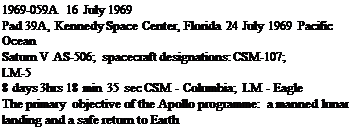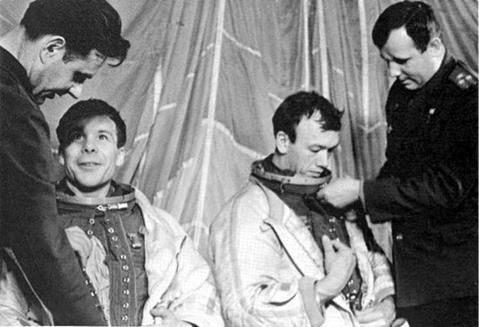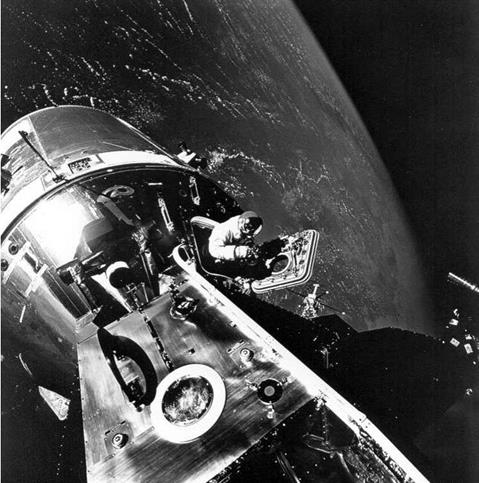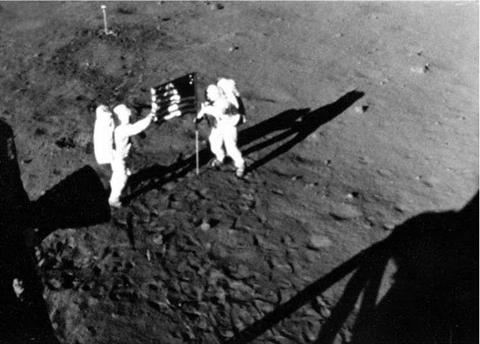SOYUZ 4 AND 5
 1969-004A (Soyuz 4)/1969-005A (Soyuz 5)
1969-004A (Soyuz 4)/1969-005A (Soyuz 5)
14 (Soyuz 4) and 15 (Soyuz 5) January 1969
Pad 31, Site 6 (Soyuz 4), Pad 1, Site 5 (Soyuz 5), Baikonur
Cosmodrome, Kazakhstan
17 (Soyuz 4) and 18 (Soyuz 5) January 1969
Soyuz 4-40 km (25 miles) northwest of Karaganda;
Soyuz 5 – 200 km (124 miles) southwest of Kustanai R7 (11A511); spacecraft serial numbers (7K-0K)
#12 (Soyuz 4) and #13 (Soyuz 5)
2 days 23 hrs 20 min 47 sec (Soyuz 4); 3 days 54 min 15 sec (Soyuz 5)
Amur (Amur – Soyuz 4); Baikal (Baikal – Soyuz 5) Docking of two manned Soyuz spacecraft and the EVA transfer of two crew members from Soyuz 5 to Soyuz 4
Flight Crew
SHATALOV, Vladimir Aleksandrovich, 42, Soviet Air Force, pilot Soyuz 4 VOLYNOV, Boris Valentinovich, 34, Soviet Air Force, commander Soyuz 5 YELISEYEV, Aleksey Stanislovich, 34, civilian, flight engineer Soyuz 5 KHRUNOV, Yevgeny Vasilyevich, 35, civilian, research engineer Soyuz 5
Flight Log
Cosmonaut Vladimir Shatalov was launched alone aboard Soyuz 4 at about 12: 29 hrs local time. Within ten minutes he was in his initial 51.7° inclination orbit, from which he would eventually manoeuvre to a new orbit with a maximum altitude of 222 km (138 miles). The next day, Soyuz 5 entered its initial 51.6° orbit after a launch from the freezing Baikonur at about 12: 05 hrs local time. It carried Boris Volynov and the two cosmonauts who should have flown Soyuz 2 in 1967, Aleksey Yeliseyev and Yevgeny Khrunov. On 16 January, the two craft docked. Soyuz 4 was the active spacecraft both during the automatic approach to a distance of 100 m (328 ft) and for the manual, Shatalov-controlled soft dock, followed by a hard dock minutes later.
The whole event had been seen on television via a camera on Soyuz 4, and was accompanied by ribald comments from the crew, much to the chagrin of ground control. The Soviets claimed that they had achieved an “experimental space station”, but at 12,926 kg (28,502 lb), the combined weight of the two spacecraft was lighter than a single Apollo. The first docking between two manned spacecraft was followed by an even more eventful space transfer, which was made externally because the docking mechanism prevented an internal transfer and there were no internal hatches.
|
Soyuz 5 cosmonauts Khrunov (left) and Yeliseyev wearing EVA suits. Except that this is a pre – Soyuz 1 image, with Komarov on the far left and Gagarin far right. The Soyuz 5 EVA was originally to have been attempted in a docking between Soyuz 1 and 2, but was cancelled when Komarov’s fatally flawed spacecraft developed problems. |
First, Yeliseyev and Khrunov floated into the Soyuz 5 Orbital Module, donned spacesuits and depressurised the module, leaving Volynov alone in the flight cabin. Wearing upgraded spacesuits to that worn by Leonov with a lifeline tether and a small breathing air pack strapped to the legs, Khrunov opened the Orbital Module hatch and floated towards the depressurised Orbital Module of Soyuz 4, followed closely by Yeliseyev and both watched by a television camera (which unfortunately returned very poor pictures of the historic event).
The first EVA to involve two spacewalkers ended after 37 minutes. After sealing the outer hatch and re-pressurising the OM, the hatch to the Descent Module was opened and Shatalov welcomed his new crew, receiving some post and reports on the launch of Soyuz 4. The event that should have occurred between Soyuz 1 and 2 two years earlier had been achieved, ahead of the USA which was, coincidentally, planning a similar EVA exercise for Apollo 9 in March 1969.
The combined spacecraft undocked on 16 January after 4 hours 33 minutes 49 seconds together. The crews conducted separate experiments in geography, geology, navigation, medicine and radio communications before Soyuz 4 came home on 17 January, carrying two crewmen who had been launched in another craft. They came down 40 km (25 miles) northwest of Karaganda, in bitter temperatures of —35°, with a flight time of 2 days 23 hours 20 minutes 47 seconds. Yeliseyev and Khrunov, the hitchhikers, had clocked up a space time of just 1 day 23 hours 45 minutes. The deserted Volynov, who reached a maximum altitude of 237 km (147 miles) in Soyuz 5, came home on 18 January, 200 km (124 miles) southwest of Kustanai, with a flight time of 3 days 0 hours 54 minutes 15 seconds.
The re-entry of Soyuz 5 almost ended in disaster as the Propulsion Module failed to separate cleanly from the Descent Module. This caused the spacecraft to begin its entry the wrong way round, with the sealed inner hatch facing forward instead of the heat shield. Volynov, who was not wearing a pressure suit, heard the separation charges fire but also saw the PM still attached out of the side window. Smelling the burning rubber of the hatch gasket, Volynov thought he would not survive re-entry. As the G forces increased, the PM suddenly separated by atmospheric friction, causing the DM to swing around to the correct orientation for re-entry. Volynov realised he would indeed survive re-entry after all but then found, like Komarov on Soyuz 1, that his main parachute had tangled. This time it untangled, but the landing was so hard, despite the soft-landing rockets working, that he broke several teeth in his upper jaw. He had landed 600 km from the intended landing site due to the difficulties in separating the components. He got out of the capsule shaken, but able to walk to a nearby peasant hut to await the rescue team. It took some time for him to fully recover from the ordeal.
Milestones
29th and 30th manned space flights 11th and 12th Soviet manned space flights 3rd and 4th Soyuz manned space flight 1st docking between two manned spacecraft 1st crew transfer
1st landing by crew launched in another spacecraft
1st “spacecraft” with four crew
2nd Soviet and 7th flight with EVA operations

 |
Flight Crew
MCDIVITT, James Alton, 39, USAF, commander, 2nd mission Previous mission: Gemini 4 (1965)
SCOTT, David Randolph, 36, USAF, command module pilot, 2nd mission Previous mission: Gemini 8 (1966)
SCHWEICKART, Russell Louis “Rusty”, 33, lunar module pilot
Flight Log
If Apollo 11 was going to make the first manned landing on the Moon, Apollo 9 would have to be a spectacular success. And so it was. The main objective of the mission was to test-fly the Lunar Module in Earth orbit. Bad colds delayed the launch of the all-up Apollo stack from 28 February to 3 March, at 11: 00 hrs local time. Once in orbit, command module pilot Dave Scott separated from the S-IVB stage and performed the first transposition and docking manoeuvre to extract the LM, which had been nicknamed Spider because of its arachnid-like appearance. The Command Module was called Gumdrop after the appearance of the CM when it was covered in blue wrappings as it was transported across the US. The individual names were chosen because of the need to identify the communications sources during the joint flight, a procedure that continued to the end of the Apollo lunar programme in 1972.
Interestingly, the S-IVB stage was restarted twice for the injection into solar orbit, but with slightly less speed than planned. Had the burn been for a manned trans-lunar injection, a Moon-landing mission could have been aborted. Meanwhile, in Earth orbit, Jim McDivitt commanded the SPS engine to fire four times, changing the altitude parameters of the 32.6° inclination orbit and testing the structural dynamics of the joint spacecraft. The maximum altitude achieved during the mission was 200 km (124 miles). On the third day, dressed in full space gear, McDivitt and Rusty
|
Dave Scott performs a stand-up EVA during Apollo 9 |
Schweickart entered Spider for the first checkout, while it was still attached to Gumdrop. This included a 367-second firing of the descent engine, which for the final 59 seconds was manually throttled by McDivitt, the first such manoeuvre in space history.
The SPS engine was fired again to fine-tune the orbit for the joint Spider – Gumdrop rendezvous and docking mission, but space sickness hit Schweickart, cancelling his EVA wearing the fully independent Apollo Portable Life Support System (PLSS) spacesuit, during which he planned an external transfer from the porch of the LM to the Command Module. However, he did recover enough to perform a 37-minute EVA standing on the porch on 7 March. The EVA resulted in some classic photographs. On 8 March came the big test. Spider was separated from
Gumdrop and fired its descent engine twice, ending up 19.2km (12 miles) higher. Then, for the first time, the LM ascent engine was fired, after separation of the descent stage, placing it 120 km (75 miles) behind and 16 km (10 miles) below Gumdrop, to simulate lunar ascent and the rendezvous and docking manoeuvre.
Six hours later, Spider and Gumdrop were together, but not before McDivitt’s eye-straining final docking, which resulted in the recommendation that on future flights this should be performed by the CMP. The ascent stage of Spider was separated as its engine fired again, to place it in a high-Earth orbit as the crew in Gumdrop wound down the mission with detailed Earth observations and photography. Re-entry was delayed one orbit because of fears of high seas in the splashdown area, giving Apollo 9 another first – the first extended US manned space flight. After a 3.6m/sec (12 ft/sec) burn of the SPS, reducing the speed by 353 kph (219 mph), enough to induce re-entry, Apollo 9 splashed down safely at 23.25° north 68° west at T + 10 days 1 hour 0 minutes 54 seconds, some 5 km (3 miles) from USS Guadalcanal. Only one more test remained before the Moon landing.
Milestones
31st manned space flight 19th US manned space flight 3rd manned Apollo CSM flight 1st manned Apollo LM flight
1st manned flight in spacecraft unable to return to Earth
1st manual engine throttling
6th US and 8th flight with EVA operations

 |
Flight Crew
STAFFORD, Thomas Patten Jr., 38, USAF, commander, 3rd mission Previous missions: Gemini 6 (1965); Gemini 9 (1966)
YOUNG, John Watts Jr., 38, USN, command module pilot, 3rd mission Previous missions: Gemini 3 (1965); Gemini 10 (1966)
CERNAN, Eugene Andrew, 34, USN, lunar module pilot, 2nd mission Previous mission: Gemini 9 (1966)
Flight Log
The riskiest space flight yet, Apollo 10 was to simulate a Moon landing in the final test before Apollo 11. Had development of the Lunar Module not been delayed, it is quite possible that Apollo 10 would have made the first real landing, making its commander Tom Stafford and LMP Eugene Cernan the first men on the Moon. Apollo 10 left new launch pad 39B at the Kennedy Space Center at 12: 49 hrs local time on 18 May 1969 and placed the S-IVB and Apollo stack in a 32.5°, 184 km (114 miles) apogee Earthparking orbit. Then the orbital speed was increased from 7,800 m/sec to 11,171 m/sec (25,593 ft/sec to 36,651 ft/sec) by the S-IVB’s engine.
Soon after, Apollo 10 became Charlie Brown and Snoopy (named after the popular Peanuts cartoon characters created by Charles L. Schultz). For the mission, Charlie Brown exchanged his WWI flying ace goggles and scarf for a space helmet, while Snoopy the beagle was a symbol of quality performance. As the LM was extracted from the spent stage, it was seen live on the first colour television show from space. Happy TV shows were beamed from the light-hearted crew en route to the Moon, which needed only one SPS mid-course manoeuvre, rather than the planned
|
Stafford (left) and Young in the Apollo 10 Command Module |
four, such was the accuracy of the flight profile. At about T + 76 hours, Apollo 10 reached lunar orbit, which was circularised at 110 km (68 miles). Some 14 hours later, the risky, untried part of the mission began.
Snoopy undocked and flew in station-keeping mode for a while before firing its descent engine for a brief 27.4 seconds, simulating a lunar landing and taking Stafford and Cernan to within 15.52 km (10 miles) of the lunar surface. Amid high excitement, the crew described the scene of boulders bigger than houses and a magnificent Earthrise, as Snoopy flew over the Sea of Tranquillity – Apollo 11’s target – testing the all-important LM radar. The descent engine was fired again, twice, before staging. Because a switch had been left in the wrong position in Snoopy’s cockpit, the staging, achieved at the second attempt, placed the ascent stage in an uncontrollable gyration, which at least led the LMP Cernan volubly to consider his fate.
Control regained, Stafford fired the ascent engine for 15 seconds, to simulate the rise from the lunar surface to rendezvous with Charlie Brown – and the lonely John Young. Careful RCS thruster firings gently nudged the LM towards the CM and at T + 106 hours, docking was achieved. After 31 lunar orbits, in 61 hours 31 minutes, Apollo 10 leapt from the Moon, and three days later flew into Earth’s atmosphere at a record manned speed of 39,897 kph (24,792 mph), landing at T + 8 days 0 hours 3 minutes 23 seconds, at 165° west 5°south, some 6.4 km (4 miles) from the USS Princetown.
Milestones
32nd manned space flight
20th US manned space flight
4th Apollo manned flight
4th Apollo CSM manned flight
2nd Apollo LM manned flight
1st flight by experienced multi-crew
1st flight by two manned craft in lunar orbit
1st crewman to fly solo in lunar orbit (Young)
2nd manned flight to and orbit of the Moon
Fastest Apollo re-entry speed from lunar distance – 39,897 kph

 |
Flight Crew
ARMSTRONG, Neil Alden, 38, civilian, commander, 2nd mission Previous mission: Gemini 8 (1966)
COLLINS, Michael, 38, USAF, command module pilot, 2nd mission Previous mission: Gemini 10 (1966)
ALDRIN, Edwin Eugene “Buzz”, 39, USAF, lunar module pilot, 2nd mission Previous mission: Gemini 12 (1966)
Flight Log
Commander Neil Armstrong reckoned that the chances of total success for the first attempt to land on the Moon on Apollo 11 were 50: 50. Six hundred million people all over the world watched on television as Apollo 11 began its journey at 09: 32 hrs local time from the Kennedy Space Center. Eleven minutes 46 seconds later, Armstrong and his crew of Mike Collins and Buzz Aldrin were over the first hurdle – 184 km (114 miles) above the Earth in a 32.7° inclination orbit. The mission was starting quietly and it continued this way, with the rather sombre crew keeping comments to a minimum. The trans-lunar injection burn, lasting 5 minutes 47 seconds, was a success, as was the transposition and docking manoeuvre by Collins.
Some TV broadcasts were made and the avidly-followed mission continued with Armstrong and Aldrin, in their spacesuits, checking out the LM, which had been named Eagle. Apollo 11 achieved lunar orbit with a 347-second SPS burn at T + 75 hours 50 minutes. The orbit was circularised by a second SPS “tweak” at 110 km (68 miles). The climax approached as Eagle separated from the Command Module Columbia at T + 100 hours 12 minutes. One hour 20 minutes later, with Eagle on the far side of the Moon, the descent engine fired for 30 seconds to begin descent orbit insertion (DOI). Fifty-seven minutes later, both Eagle and Columbia emerged from
|
Apollo 11 astronauts Aldrin and Armstrong deploy the Stars and Stripes at Tranquillity Base |
the far side, with Eagle now approaching its 14.56 km (9 miles) low point or perilune, when the powered descent initiation burn (PDI) was to begin.
The 756.3-second long burn seemed interminable to the waiting world, but to the crew it went so fast that neither could recall very much about it, other than the computer alarms that nearly aborted the landing. An overloaded computer was protesting, but ground controller Stephen Bales reported that all was well. The mission was given a go to land, but with seconds left Armstrong could see that the autopilot was taking Eagle into a boulder-strewn crater. He took partial control and amid clouds of dust, landed with between 15 and 20 seconds of fuel left, at T + 102 hours 45 minutes. The time in the UK was 21: 18 hrs on 20 July.
The landing site, named Tranquillity Base by Armstrong, was about 6.4 km (4 miles) downrange of the planned touchdown point, at 0°41’15" north 23°0’26" east. Having reached the Moon, Armstrong could start to think about what his first words would be when he stepped upon it. Although in the Gemini programme the pilot went for the walks, on Apollo, because of the design of the Lunar Module hatch which opened towards the LMP thus trapping him, the commander would go out first, which was regarded as a logical thing to do anyway given the prestigious nature of the event. Armstrong’s right boot touched the lunar dust at T + 109 hours 42 minutes, 03: 56 hrs British time on 21 July. As he stepped onto the lunar surface, Armstrong said: “That’s one small step for a man, one giant leap for mankind.’’ Armstrong was
joined by Aldrin, who took the TV camera and placed it on a tripod some distance away so that both astronauts could be seen, looking like ghosts on the black and white TV.
The flag was raised and the short moonwalk was interrupted by a gushing President Nixon. The astronauts rushed to finish the deployment of EASEP experiments but Armstrong did find time to take some classic photographs of Aldrin, the first person to make two spacewalks. Although he had the camera briefly, to take pictures of his boot print and a panorama of the surface, Aldrin did not take a formal still of the first man on the Moon, although he did happen to feature in one of the panoramas with his back to camera and standing in the shadow of the Lunar Module. The moonwalk lasted 2 hours 31 minutes 40 seconds, during which Armstrong was on the surface for 2 hours 14 minutes and Aldrin for 1 hour 33 minutes.
After 21 hours 36 minutes on the Moon, the critical ascent engine burn began, firing for 435 seconds to place Eagle’s ascent stage in orbit for its rendezvous with Collins. The SPS engine fired for 2 minutes 29 seconds and after 59 hours 30 minutes in lunar orbit, Columbia was en route for its landing at 169°west 13°north, coming down near the USS Hornet at T + 8 days 3 hours 18 minutes 35 seconds. The epic mission was over, rather ironically overshadowed by the antics of the late President Kennedy’s younger brother Edward, who was involved in a fatal traffic accident at Chappaquidick.
Milestones
33rd manned space flight 21st US manned space flight 5th Apollo manned space flight 5th Apollo CSM manned flight 3rd Apollo LM manned flight 1st manned landing on the Moon 1st walk on the Moon
3rd manned flight to and orbit of the Moon 7th US and 9th flight with EVA operations














